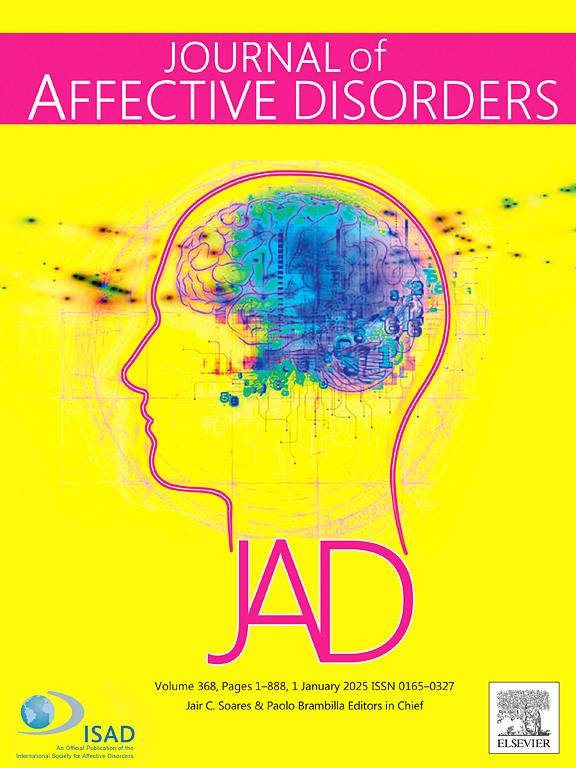Anxiety symptom trajectories and subsequent suicidal ideation among patients with major depressive disorder: A longitudinal study in China
IF 4.9
2区 医学
Q1 CLINICAL NEUROLOGY
引用次数: 0
Abstract
Background
To examine the longitudinal associations between different anxiety symptom trajectories and subsequent suicidal ideation (SI) among patients with major depressive disorder (MDD).
Methods
We used data from patients with MDD in the Depression Cohort in China. At baseline, 4, 8, and 12 weeks, anxiety symptoms were assessed using the Generalized Anxiety Disorder 7-item Scale, and trajectories were identified using latent class trajectory models. At 12, 24, and 48 weeks, SI was assessed using the Beck Scale for Suicide Ideation.
Results
We included 718 participants with a median (IQR) age of 26.0 (22.3, 31.0) years, among whom 489 (68.1 %) were female. Five trajectories of anxiety symptoms were identified: persistent mild (25.1 %), rapidly decreasing (30.1 %), persistent moderate (21.7 %), slowly decreasing (10.3 %), and persistent severe (12.8 %). Compared to the persistent mild anxiety symptom trajectory, the rapidly decreasing anxiety symptom trajectory was significantly associated with lower levels of SI (β coefficient, −0.186; 95 % confidence interval [CI], −0.296 to −0.075). Conversely, the persistent moderate anxiety symptom trajectory (β coefficient, 0.126; 95 % CI, 0.03 to 0.249) and persistent severe anxiety symptom trajectory (β coefficient, 0.334; 95 % CI, 0.185 to 0.482) were associated with higher levels of SI. No statistically significant association was found for the slowly decreasing anxiety symptom trajectory (β coefficient, 0.051; 95 % CI, −0.101 to 0.202).
Limitations
Reporting bias; Selection bias; Observational design; Generalizability.
Conclusions
Among patients with MDD, achieving reductions in anxiety symptoms may mitigate suicidal risk, and attention should be paid to the suicidal risk associated with anxiety symptoms, particularly when symptoms remain severe in the longitudinal follow-up.
中国重度抑郁症患者的焦虑症状轨迹和随后的自杀意念:一项纵向研究
背景:探讨重度抑郁障碍(MDD)患者不同焦虑症状轨迹与随后的自杀意念(SI)之间的纵向关联。方法:我们使用了中国抑郁症队列中重度抑郁症患者的数据。在基线、4、8和12 周,使用广泛性焦虑障碍7项量表评估焦虑症状,并使用潜在类别轨迹模型确定轨迹。在12、24和48 周,使用贝克自杀意念量表对SI进行评估。结果:我们纳入了718名参与者,中位(IQR)年龄为26.0(22.3,31.0)岁,其中489名(68.1 %)为女性。确定了5种焦虑症状轨迹:持续轻度(25.1 %)、快速减轻(30.1 %)、持续中度(21.7 %)、缓慢减轻(10.3 %)和持续重度(12.8 %)。与持续轻度焦虑症状轨迹相比,快速减轻的焦虑症状轨迹与较低的SI水平显著相关(β系数,-0.186;95 %置信区间[CI], -0.296至-0.075)。相反,持续中度焦虑症状轨迹(β系数,0.126;95 % CI, 0.03 ~ 0.249)和持续重度焦虑症状轨迹(β系数,0.334;95 % CI, 0.185至0.482)与SI的高水平相关。焦虑症状轨迹缓慢下降无统计学意义(β系数,0.051;95 % CI, -0.101至0.202)。局限性:报告偏倚;选择性偏差;观察性设计;普遍性。结论:在重度抑郁症患者中,焦虑症状的减轻可能会降低自杀风险,应注意与焦虑症状相关的自杀风险,特别是在纵向随访中症状仍然严重的情况下。
本文章由计算机程序翻译,如有差异,请以英文原文为准。
求助全文
约1分钟内获得全文
求助全文
来源期刊

Journal of affective disorders
医学-精神病学
CiteScore
10.90
自引率
6.10%
发文量
1319
审稿时长
9.3 weeks
期刊介绍:
The Journal of Affective Disorders publishes papers concerned with affective disorders in the widest sense: depression, mania, mood spectrum, emotions and personality, anxiety and stress. It is interdisciplinary and aims to bring together different approaches for a diverse readership. Top quality papers will be accepted dealing with any aspect of affective disorders, including neuroimaging, cognitive neurosciences, genetics, molecular biology, experimental and clinical neurosciences, pharmacology, neuroimmunoendocrinology, intervention and treatment trials.
 求助内容:
求助内容: 应助结果提醒方式:
应助结果提醒方式:


